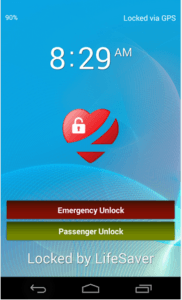With the rapid increase in the adoption of smartphones, there has also been a continued increase in the number of distracted driving related accidents. While the recent introduction of connected car technologies such as Apple’s CarPlay may help to address this issue down the road, for the next several years these solutions cannot solve the problem for the largest culprits of distracted driving — teenagers. Teen drivers are clearly not going to be driving brand new cars with high-end, expensive technology anytime soon. Until connected car technologies and other potential long-term solutions (e.g., driverless cars) become commonplace on American roadways, the distracted driving epidemic will continue to persist.
 We are highly concerned with the problem “here and now”. App providers like LifeSaver offer a low-cost, no-hardware solution which can help to address the root cause of this addiction right at the source — i.e., the mobile phone itself. We can do this by providing background apps that simply wake up and deter distraction though the use of lock screens and other technology available today. The primary challenge we see is motivating the masses to ‘want’ to do this. People are so addicted to their smartphones that they (we) just don’t want to give up that control.
We are highly concerned with the problem “here and now”. App providers like LifeSaver offer a low-cost, no-hardware solution which can help to address the root cause of this addiction right at the source — i.e., the mobile phone itself. We can do this by providing background apps that simply wake up and deter distraction though the use of lock screens and other technology available today. The primary challenge we see is motivating the masses to ‘want’ to do this. People are so addicted to their smartphones that they (we) just don’t want to give up that control.
It would be highly beneficial for government to embrace a program that works to bridge the gap for the next several years. We believe this could be accomplished by providing incentives to individuals through avenues such as car insurance providers and/or state DMV agencies. Interested in having a license or insurance? Have a mobile device? Install a certified app and you can renew your driver’s license and/or car insurance. Next, create a simple ‘bar of acceptance’ that app providers must meet to be certified. This could include a central database to validate installation if desired. We would be most willing to participate in such an effort or any smaller steps in this direction.
In the meantime, here are some recent numbers that should cause us all to pause:
> There were 3,997 unique Android handset models in 2012. In 2013 there were almost 3x at 11,868. None will connect to CarPlay.
> The growth in mobile device adoption in the US increased to 177 million in 2013 up from 136 million in 2012.
> The smartphone penetration rate for 18-24 year olds was up from 60% to 75% in the same time period. For 25-34 year olds, the penetration rate went from 64% in 2012 to 81% in 2013.
> Deaths and injuries related to distracted driving now approach 500,000 in 2014, up from 387,000 in 2011.
(primary data source: www.thinkwithgoogle/mobileplanet)
Despite tremendous efforts by government agencies and corporate funded campaigns geared towards getting people to stop distracted driving, it is clear that much more is going to be needed to curb our mobile addiction when driving.
We propose a call to action to help flood the 177 million mobile devices in the U.S. with LOW cost solutions that people can accept and live with. Let’s put more focus into bridging the gap from now until when the bulk of mobile devices can be controlled directly via in-car solutions which hopefully are designed to stop distraction, versus creating more distraction.

